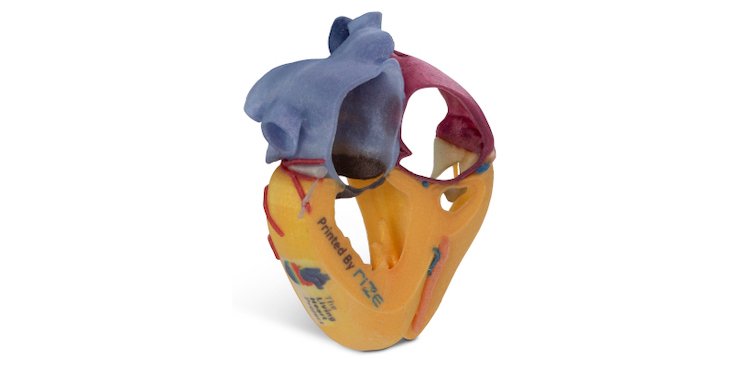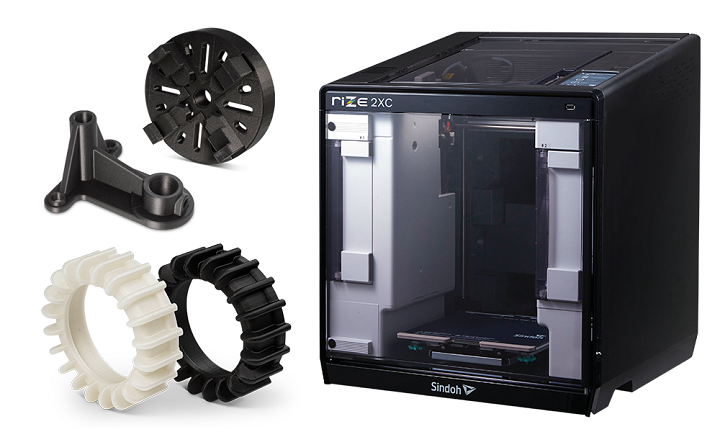Rize3D has gone out of business. However, if you have a Rize system, you can still obtain service and filament through the firm Palitra3D. The company also aims to license out the technology that it has obtained from Rize3D. So, in a somewhat new form or by being run by someone else, Rize3D could rise again.

Full color 3D printed model of a heart made with Simpleware on an XRIZE 3D printer. Image courtesy of XRIZE.
On the Palitra3D website, the company stated, “RIZE is no longer functioning as a company but don’t worry! Eugene Giller founded RIZE with one mission – to bring functional printing to the masses with advanced features like composite materials & full-color 3D printing. Thanks to the incredible core team who worked tirelessly to create a technology ecosystem unlike any other filament 3D printer in the world, his vision became reality. While we are incredibly thankful for everything RIZE was able to accomplish, it was time to close that chapter to keep the initial vision alive. Welcome to the next chapter. Palitra3D.”
Since its 2016 launch, Rize3D released a number of different 3D printers. While they all relied on a form of material extrusion technology, the company was best known for its Augmented Polymer Deposition (APD) process. APD combined the melting of thermoplastic filaments with the use of a specialty inkjet printhead that made it possible to deposit colorful and functional inks onto printed parts. With the XRIZE system, this meant jetting cyan, magenta, yellow, and black inks onto engineering-grade material. A specialty release Ink was also jetted between the automatically-generated supports and the part itself, so that users could quickly peel the supports away for a smooth surface finish with no additional finishing required.
APD gave people interesting parts to look at. Moreover, these components were reasonably affordable as well. The systems could be used in a variety of environments, particularly factories and offices, due to their high level of safety. By combining inexpensive filament with color, you could produce effective parts with good labelling. There were a lot of potential applications for Rize’s process and I could see someone commercialize the technology again.
I really like the combination of inkjet and filament. This really would give a firm with a lot of inkjet expertise a toe hold in the market. They could then focus on jetting inks onto parts, not just color, but also things like conductive materials and coatings. This would allow the filament to produce the cheap, rough bulk of the part and the additional inks to provide added functionality.
I’ve always loved Rize3D´s groundbreaking way to get the best of both inkjet and material extrusion. However, with so many potential exit partners and such potential, why did Rize3D fail? Over the past several years, the firm has released a handful of systems starting with the monochromatic Rize One, the full-color XRIZE, the home office 2XC, and the larger but still cost effective RIZE 7XC.
One problem off the bat is that I didn’t until just know know that the firm even had the 2XC printer. Rize never really had the funds to make a huge marketing impact. It also didn’t develop the applications or stories necessary to stay relevant. It never was completely able to punch through to our collective consciousness to be top of mind.
Part of that is a funding issue. Another part, however, is that if you have great, colorful components and a safe process to make them with, you might be lulled into a false sense of security. It seems like you’re inherently useful and good and, thus, relevant. But, in our market you need the perfect fit for the perfect application to be relevant enough for people to purchase your system and really engage with it. This is especially true if you are one firm pushing a technology by yourself.
If you can’t manage to convince the world that you’re an earth-shattering revolution, then you need a tightly knit army of converts to your cause. And with something great and ephemeral, you’re not going to cut it. So, Rize never had a small core of passionate users extolling its virtues and singing its praises. APD was a very interesting technology that also had a lot of different potential uses from toys and prototypes to end-use components and spare parts. With such a broad application area and such potential, it can be hard to focus and find your true north.
If you have a technology that can only really create small medical parts well and is expensive, then this is super limiting. However, you also know what you have to do to get customers and where to get them. You can’t do toys, you can’t do bulk, you can’t do prototypes, you can’t do volume, you can’t even do inexpensive medical devices either. What this does is give you a lot of focus. You know you have to succeed in a tight market and you know you have to execute really well there.

Toys made with Rize3D’s full color 3D printing process. Image courtesy of Rize3D.
My view is that, with Rize3D, there were just so many potential markets and customers that the team really was overwhelmed with the possibilities. With such choices, they were subsequently unable to filter through the noise to get enough signals to sustain them. With a broad field of potential clients and applications, it can be almost impossible to find the right clients and applications. And without a few crucial clients that have profitable key applications, it’s difficult to grow a business and a user base. In this case, therefore, we have to conclude that there were just too many possible roads that all obscured the path to revenue.
Subscribe to Our Email Newsletter
Stay up-to-date on all the latest news from the 3D printing industry and receive information and offers from third party vendors.
You May Also Like
3D Printing Unpeeled: New Arkema Material for HP, Saddle and Macro MEMS
A new Arkema material for MJF is said to reduce costs per part by up to 25% and have an 85% reusability ratio. HP 3D HR PA 12 S has been...
3D Printing News Briefs, January 20, 2024: FDM, LPBF, Underwater 3D Printer, Racing, & More
We’re starting off with a process certification in today’s 3D Printing News Briefs, and then moving on to research about solute trapping, laser powder bed fusion, and then moving on...
3D Printing Webinar and Event Roundup: December 3, 2023
We’ve got plenty of events and webinars coming up for you this week! Quickparts is having a Manufacturing Roadshow, America Makes is holding a Member Town Hall, Stratafest makes two...
Formnext 2023 Day Three: Slam Dunk
I’m high—high on trade show. I’ve met numerous new faces and reconnected with old friends, creating an absolutely wonderful atmosphere. The excitement is palpable over several emerging developments. The high...
































